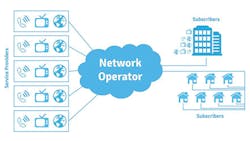Open Access Is the Force —
If you work in the ICT/telecom industry, you know that the broadband world has been flipped upside down over the past few years, and has come into the public eye more than ever before. This coincides with some great upheavals that are afoot as broadband deployment strategies are hotly debated.
Many of these disrupting forces are opening the door to more questions than answers, questions that we need to collectively think about in a systematic way before we can truly realize the technological gains we know to be around the corner.
As with any grouping of complex systems, these conundrums and solutions are interrelated, so it makes sense to paint a picture in broad strokes, and outline at a high level what the issues are, how they relate to each other, and what a viable forward path looks like.
The Big Questions
#1. How can we speed deployment of high-speed connectivity to rural America, small towns, and underserved urban areas, without either propping up legacy networks we know to not be future proof, or dramatically reducing the definition of broadband?
#2. What role, if any, should municipal, county, and state governments, play in the deployment of next-gen networks?
#3. Why should telcos/ISPs have to bear the brunt of the CapEx to reach these unserved and underserved communities, and what is the role of both public and private funds in supplying the CapEx if the ISPs can’t or shouldn’t be expected to do so?
The common threads through all these questions revolve around funding and ownership models. Traditionally, ILECs and CLECs possess both a fierce desire to protect their turf against additional competition, and a strong will to be solely responsible for the operation and maintenance of their plant. While these positions are completely understandable from a business perspective, the unfortunate side effect is that millions of Americans have been left out.
While the statistics are likely familiar to most in the industry, I’ll repeat them here as I think it’s important to remember the magnitude of the problem: 10.6 million US households have no wired access to broadband, 50 million US homes have access to either only 1 broadband provider or none at all, and a whopping 4.9 million US homes do not even have access to 3 Mbps.
It is true that we could largely "fix" this problem by simply reclassifying the broadband threshold with slower download and upload speeds. At first glance, this would give the appearance of a larger percentage of the country covered by "broadband" service, but I think it’s fairly obvious that this is merely a cosmetic fix that does nothing to address the underlying issues of the digital divide. Rural America is devastatingly underserved, and this lack of access will continue to cause economic stagnation, and population loss to better-served urban areas, and will further deepen the schism between the Digital Haves and the Digital Have Nots.
The idea that government has no business competing with the private sector has long been upheld as reason to ban municipally owned networks. And to be honest, this is a compelling argument; I don’t think many on either side of the aisle suffer from the illusion that government is always (if ever) more efficient than the private sector.
However, this argument loses credibility if you set aside some unnecessary assumptions which are baked into the way we’ve traditionally thought of network ownership. Imagine for a moment that UPS, FedEx, and DHL, all had to build their own road to your home in order to deliver a package to you. It’s obvious that this would be a terrible way of going about their business, but this is exactly the situation the broadband industry finds itself in, and it is why incumbent carriers fight tooth and nail to protect the "roads" they’ve already built to millions of households.
If we take away the assumption that ISPs should build out their own plant, how would anybody get service? Imagine that cities, in partnership with private equity groups, engineering firms, and construction companies, built the networks and then charged the service providers for the right to use that infrastructure via SDN. Suddenly the CapEx to build the infrastructure doesn’t have to come from the service providers, and the consumer benefits substantially, as the only way in which the telcos/ISPs can differentiate themselves from the competition is through price and customer service. Imagine virtualized service provisioning, wherein a consumer could switch providers with the click of a mouse and instantly begin receiving service from a different ISP, without having to wait for a truck roll that will arrive at their home in a week’s time, between the hours of 8:00am and 12:00pm.
It Exists?
This paradigm exists. It is called Open Access, and it has been embraced in other parts of the world with great success. The model is beginning to take hold here in the US as well, though the rate of adoption has so far been slow. There is concern among potential network owners, public private partnerships (P3s), electric cooperatives, and cities, that it will be difficult to woo service providers to their networks, given that their traditional MO is to build and operate the networks themselves. There is also concern that if a P3 or city invests in FTTP infrastructure, the incumbents in their market will simply overbuild and reduce prices.
While these concerns are reasonable, they can be successfully addressed. It is likely the case that the big, household names may be slow on the uptake when it comes to riding third-party-owned networks all the way to the customer premises. However, it is also true that there are innumerable small companies who will be happy to fill the void, capturing dramatically more market share than they ever could if they had to expend their own capital to reach those new subscribers.
When it comes to the threat of competitive companies overbuilding, municipalities possess tools to protect their investments. For example, they control access to the right-of-way, which allows for ordinances such as dig-once policies to have some real teeth in ensuring that their plant, be it lit, dark, or conduit, is used when anyone wants to place some fiber.
Potential network owners, be they cities, counties, electric cooperatives, or any blend of P3, also can have at their disposal the expertise of hired engineering consultants. Firms such as Foresite Group, Inc. can hold the umbrella, as it were, from providing detailed market assessments to accurately determine build costs and take rates, to creating and presenting business cases to investors, generating sophisticated cost-optimized designs, and brokering deals between service providers and the network owner. Consultants capable of providing these services can mean the difference between success and failure.
The truth is that Open Access has the potential to address a lot of our nation’s broadband woes. It will benefit not just consumers and small rural cities, but even the big telco/ISPs as well. For example, most of the biggest ISPs are not present in much of rural America, as it has been difficult to make a business case to build there when low hanging fruit like MDU-rich metro areas abound. My guess is that most of these firms would be happy to provide services to rural America if they needn’t expend CapEx to do so, and access to these new markets would help soften the blow of lost market share elsewhere in their footprints. It is also the case that many of the big incumbents, who would in theory be the ones to lose out should Open Access become more common here, are already beginning to shift to a role more focused around providing content than Internet service.
I believe that our current way of doing things is not only non-competitive, but has failed our rural citizens, and that a true free market system like Open Access would both be better for consumers, and allow for smaller companies to more easily compete. After all, such competition is at the heart of our free market ideals. I think it is time we live up to them.
Sources
Assessing the Impact of Removing Regulatory Barriers on Next Generation Wireless and Wireline Broadband Infrastructure Investment, by Hal Singer, Economists Incorporated, Ed Naef and Alex King, CMA Strategy Consulting. Economists Incorporated, June 2017. http://ei.com/wp-content/uploads/2017/06/SingerAssessingImpact6.17.pdf
"50 million US homes have only one 25Mbps Internet provider or none at all" by Jon Brodkin, ARS Technica, June 30, 2017. https://arstechnica.com/information-technology/2017/06/50-million-us-homes-have-only-one-25mbps-internet-provider-or-none-at-all/






